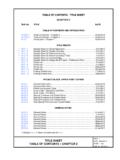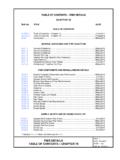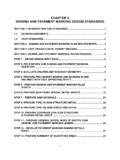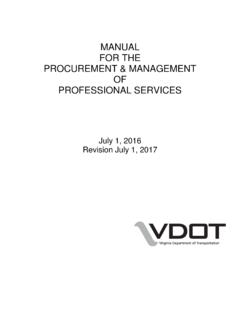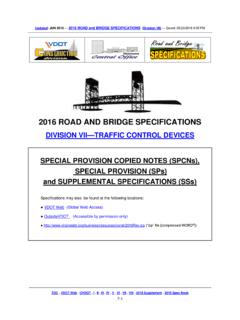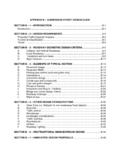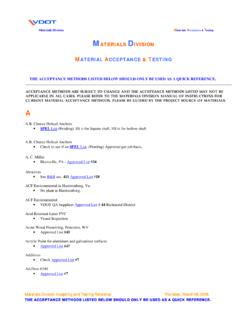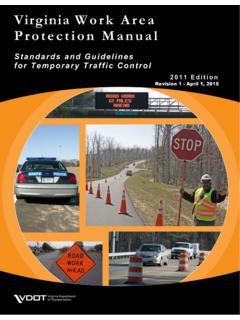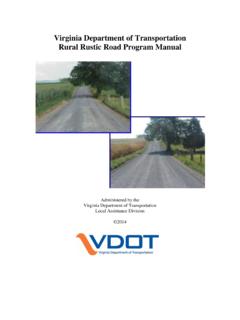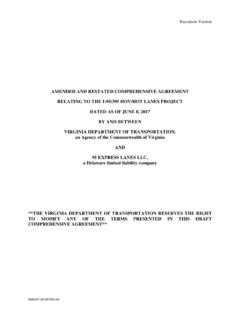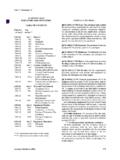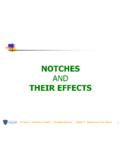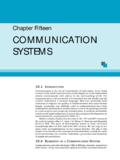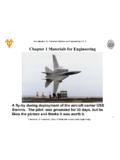Transcription of CHAPTER 2 LIGHTING DESIGN STANDARDS AND …
1 CHAPTER 2 LIGHTING DESIGN STANDARDS AND guidelines SECTION 1: INTRODUCTION AND STANDARDS .. 1 VIRGINIA S LIGHTING LAW (SENATE BILL SB379 & SB1351) .. 1 ACKNOWLEDGMENTS .. 2 LIGHTING ANALYSIS METHODS .. 2 LIGHTING LEVELS .. 2 LAMP AND LUMINAIRE DEPRECIATION FACTORS .. 2 VDOT LIGHTING STANDARDS .. 3 VDOT LIGHTING POLE FOUNDATIONS .. 4 VDOT ELECTRICAL SERVICE .. 5 CONDUIT .. 6 TRANSFORMER BASES VERSUS JUNCTION BOXES .. 6 CONDUCTOR CABLE .. 7 STANDARD LIGHTING SYSTEMS UTILIZED BY VDOT .. 7 Underpass LIGHTING .. 8 LIGHTING on Bridges .. 8 LIGHTING Near Airports .. 9 Tunnel LIGHTING .. 9 LIGHTING for Other Streets and Highways .. 9 LIGHTING at Intersections or Other Isolated Traffic Conflict Areas .. 9 SECTION 2: PLAN REQUIREMENTS .. 11 GENERAL .. 11 STAND-ALONE TRAFFIC ENGINEERING LIGHTING PLANS.
2 12 LIGHTING PLANS INCORPORATED INTO A COMPLETE SET OF ROADWAY CONSTRUCTION PLANS .. 13 SECTION 3: VDOT PROJECT DEVELOPMENT PROCESS .. 14 VDOT Traffic Engineering DESIGN STANDARDS and guidelines CHAPTER 2 Roadway LIGHTING ii SECTION 4: LIGHTING DESIGN PROCESS .. 15 STEP 1 PERFORM LIGHTING WARRANTS .. 15 STEP 2- SELECT POLE AND LUMINAIRE TYPES .. 15 Conventional or Cobrahead Pole .. 15 Offset 16 Architectural LIGHTING .. 16 High Mast Luminaire and Pole Combination .. 16 STEP 3 PREPARE BASE PLAN .. 17 STEP 4 PLACE POLES .. 18 Clear Zone and Breakaway Base 19 Median Barrier LIGHTING Considerations .. 20 STEP 5 - FIELD VISIT AND DETERMINE THE POWER SOURCE .. 21 Grid Maps .. 21 Primary Power .. 21 Easements and Right-of-Way .. 22 Locate primary power directly adjacent to the VDOT right-of-way.
3 22 STEP 6 - PLACE ELECTRICAL SERVICE AND LIGHTING CONTROL CENTER .. 22 STEP 7 - LAYOUT THE CONDUIT AND WIRING SYSTEM .. 23 STEP 8 - CALCULATE VOLTAGE DROP, WIRE SIZE, CONDUIT SIZE AND JUNCTION BOX SIZE .. 23 STEP 9 PLAN SHEET DEVELOPMENT .. 24 LIGHTING System Survey and Alignment .. 26 STEP 10 - DETERMINING SALVAGE AND REMOVAL ITEMS .. 27 STEP 11 - DETERMINING QUANTITIES .. 28 Conduit, Cable, and Trench .. 28 Bored Conduit .. 28 Pipe Sleeve .. 28 Equipment Grounding Conductor (EGC) .. 28 VDOT Traffic Engineering DESIGN STANDARDS and guidelines CHAPTER 2 Roadway LIGHTING 1 SECTION 1: INTRODUCTION AND STANDARDS Good visibility under day or night conditions is one of the fundamental requirements enabling motorists to move along roadways in a safe and coordinated manner. Properly designed and maintained street LIGHTING should produce uniform LIGHTING levels conforming to industry STANDARDS .
4 Those levels should facilitate the visibility of motorists, pedestrians, and other objects at night or in situations in which light levels are diminished ( , a tunnel). VIRGINIA S LIGHTING LAW (SENATE BILL SB379 & SB1351) Senate Bills SB379 and its amendment SB1351 were passed by the Virginia Assembly and signed into law effective July 1, 2003. The law provides strict requirements on the procurement of light fixtures. The law states: Require state public bodies to procure only shielded outdoor light fixtures and provide for waivers of this requirement when the Division determines that a bona fide operational, temporary, safety or specific aesthetic need is indicated or that such fix tures are not cost effective over the life cycle of the fixtures.
5 For the purposes of this subdivision, "shielded outdoor light fixture" means an outdoor light fixture that is (i) fully shielded so that no light rays are emitted by the installed fixture above the horizontal plane or (ii) constructed so that no more than 2 percent of the total luminaire lumens in the zone of 90 to 180 degrees vertical angle is permitted, if the related output of the luminaire is greater than 3200 lumens. In adopting regulations under this subdivision, the Division shall consider national STANDARDS for outdoor LIGHTING as adopted by the Illuminating Engineering Society of North America (IESNA). Effective July 1, 2003, the Virginia Department of Transportation shall DESIGN all LIGHTING systems in accordance with current IESNA STANDARDS and recommended practices.
6 The LIGHTING system shall utilize fixtures that minimize glare, light trespass, and skyglow, all as defined by the IESNA, while still providing a comfortable, visually effective, safe, and secure outdoor environment in a cost-effective manner over the life cycle of the LIGHTING system. Any roadway LIGHTING designed, installed or funded under the auspices of the Department must be in accordance with this legislation. This includes, but is not limited to, construction projects, LIGHTING installed by permit, intersection LIGHTING (including that installed by Regional Signal Contracts), etc. Typically the Central Office Location and DESIGN (L&D) Division Traffic Engineering DESIGN Section designs or reviews designs of others to ensure the LIGHTING designs are appropriate.
7 For VDOT traffic signal projects with proposed intersection LIGHTING , if a standard DESIGN does not apply to a specific intersection configuration, VDOT Central Office L&D Division Traffic Engineering DESIGN Section shall review or provide LIGHTING designs for those locations to ensure compliance. VDOT Traffic Engineering DESIGN STANDARDS and guidelines CHAPTER 2 Roadway LIGHTING 2 Additionally, any maintenance or maintenance replacement of the LIGHTING system must be done in a manner not to alter the integrity of the original DESIGN . Any luminaire replacement must be identical to those originally installed or a new DESIGN or DESIGN review will need to occur. ACKNOWLEDGMENTS The following references are used throughout the Section: FHWA Roadway LIGHTING Handbook AASHTO An Informational Guide for Roadway LIGHTING IESNA Recommended Practices for Roadway LIGHTING IESNA RP-8.
8 The most current edition of this document is, RP-8-05 Reaffirmed. IESNA Recommended Practices for Tunnel LIGHTING IESNA PR-22. The most current edition of this document is, Recommended Practices for Sign LIGHTING IESNA PR-19. The National Electric Code (NEC), National Fire Protection Association (NFPA). (Latest adopted NFPA 70/NEC by VDOT) LIGHTING ANALYSIS METHODS VDOT requires all roadway LIGHTING designs to meet the LIGHTING criteria as discussed in the current IESNA publication, Recommended Practices for Roadway LIGHTING (RP-8). The illuminance criteria must be met for all sections of a roadway project. This guideline also includes meeting the criteria for the Veiling Luminance Ratio (Lv/Lave) and The Luminance Method. The AGI-32 LIGHTING DESIGN software or other LIGHTING DESIGN software shall be utilized to determining the levels required for the final roadway light plan.
9 LIGHTING LEVELS The DESIGN must be appropriate for the site and must provide the level and uniformity of light suggested in the current IESNA publication, Recommended Practices for Roadway LIGHTING (RP-8). The recommended DESIGN values represent the minimum maintained average LIGHTING level. Facilities may be designed with higher average LIGHTING levels, but must provide the required uniformity. In all cases, the VDOT Traffic Engineering/Location and DESIGN Manager must approve higher LIGHTING levels. LAMP AND LUMINAIRE DEPRECIATION FACTORS The LIGHTING system designer must consider the luminaire maintenance factor, or light loss factor (LLF) in determining the light output for a luminaire (LLF detail in Figure 2-1). For further information, see the FHWA Roadway LIGHTING Handbook at.
10 VDOT Traffic Engineering DESIGN STANDARDS and guidelines CHAPTER 2 Roadway LIGHTING 3 Specifically: The LLF for a conventional luminaire is: LLF = (LLD) x (LDD) x (ballast factor) = VDOT LIGHTING STANDARDS Pole Standard LP-1 Used for Conventional (Cobra Head) or Shoebox Luminaires. The most common structure used is the 30-foot to 50-foot pole with a luminaire and bracket arm. The bracket arm typically places the luminaire directly over the edge of the travel lane. Pole Standard LP-2 Used for Offset or Shoebox Luminaires. The offset pole is typically a 30-foot to 50-foot pole with a luminaire. New offset luminaires are frequently mounted with a 0-degree tilt, or pointing straight down, with single or double tenon. The following values for LLF are used on VDOT LIGHTING projects: Conventional and Offset LIGHTING STANDARDS : LLF = High Mast LIGHTING STANDARDS : LLF = Architectural LIGHTING LLF = 02468101214161820222420406080100 Hours of Operation (x1000)% Initial LumensFigure 2-1: Light Loss Factor VDOT Traffic Engineering DESIGN STANDARDS and guidelines CHAPTER 2 Roadway LIGHTING 4 Pole Standard LP-3 Used for High Mast Luminaires.
